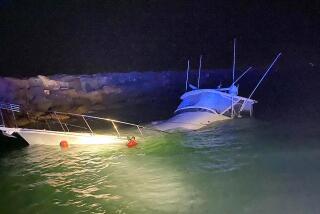Manslaughter Case Opens for Skipper in Fatal Boat Crash
- Share via
Virl Earles was operating a speedboat at 30 m.p.h. in a 5-m.p.h. zone in the dark when it crashed into a concrete buoy in Anaheim Bay near Seal Beach in 1984, killing five people, the prosecution in his trial said in opening statements Thursday.
Deputy Dist. Atty. John Conley told jurors in Orange County Superior Court Thursday that the speed at which Earles was operating the craft, plus the fact the 20-foot, six-seat boat was overloaded, carrying nine people without life jackets, amounted to “criminal negligence or dangerous conduct” by Earles.
Earles, 30, of Seal Beach faces five counts of involuntary manslaughter.
Evidence of Earles’ blood alcohol content, which police reported at slightly above .10, was thrown out at Earles’ preliminary hearing in July after the court learned that police officials had failed to get proper consent from Earles before testing him.
Boat Hit Mooring
Earles, along with five other men and three women, got into the boat in the early morning hours on Oct. 28, 1984, for a trip from Peter’s Landing in Huntington Harbour to the Long Beach Harbor to view the Queen Mary.
Earles drove the boat into the mooring buoy during their return trip, a few hundred yards out in waters between Sunset Beach and Seal Beach.
The five who died were John Bakos, 22; Ronald Myers, 22; Anthony Sutton, 27, all of Seal Beach; Kathy Weaver, 24, from Laguna Beach, and Patricia Hulings, 20, of Downey.
Earles was thrown from the boat and severely injured. Carol Kemble, 25, of Laguna Beach, and Ernest Chavez, 25, of Bakersfield, were thrown into the water but managed to climb onto the 11-foot buoy and hold Earles’ head out of the water as he lapsed in and out of consciousness.
Stephen Brennan, 24, of Huntington Beach, the fourth survivor, managed to swim ashore for help despite a shattered pelvis and internal bleeding.
Conley told the jurors that three of the five who died had drowned, but that it is not known whether they were first so stunned that they could not swim. The other two died from injuries.
‘A Tragic Accident’
Earles’ attorney, Gary Pohlson of Santa Ana, said before the trial the collision was “a tragic accident; but that’s all it was, an accident.”
Even though Conley cannot use the blood alcohol report, he can show jurors that Earles had been drinking with friends at the Red Onion at Peter’s Landing for several hours.
Pohlson acknowledged to jurors that everyone in the group had been drinking but emphasized that there was no alcohol on the boat during the Queen Mary trip.
Jurors on Thursday got a clear picture of the differences in the two attorneys’ views.
Conley said he would show that Earles drove the boat 170 feet beyond the channel’s boundaries, which is illegal, that Earles had been operating the boat recklessly, doing loops and figure eights, and that Earles was familiar with the bay and should have known about the buoys, which had been outside the channel more than 10 years.
Points of Contention
Pohlson countered that Earles drove out of the channel only because one of the navigation lights marking the channel was out, and a replacement light had been put at a different place. The loops and figure eights only showed that Earles was in good control of the boat, Pohlson said. And Earles did not know about the buoys because he thought he was in the middle of the channel out of danger, Pohlson said.
Two points of contention at the trial will be how fast Earles was operating the boat and whether he should have known that the boat’s load should have made him extra cautious.
Earles told police he was going 30 m.p.h. in the 5 m.p.h. zone. But Pohlson said Earles had just pulled back the throttle and was slowing.
Conley said he wants to present evidence that the boat would not handle as well with nine people aboard and that Earles should have been especially cautious.
But Pohlson is trying to keep out such evidence. He claims that the load was not a factor. “It wasn’t just Mr. Earles who failed to know that buoy was there,” Pohlson argued to Superior Court Judge Jean Rheinheimer. “Not one single person on that boat saw that buoy. No one yelled ‘Look out.’ ”
Rheinheimer said she would take the argument about the boat’s load under submission.
More to Read
Sign up for Essential California
The most important California stories and recommendations in your inbox every morning.
You may occasionally receive promotional content from the Los Angeles Times.












